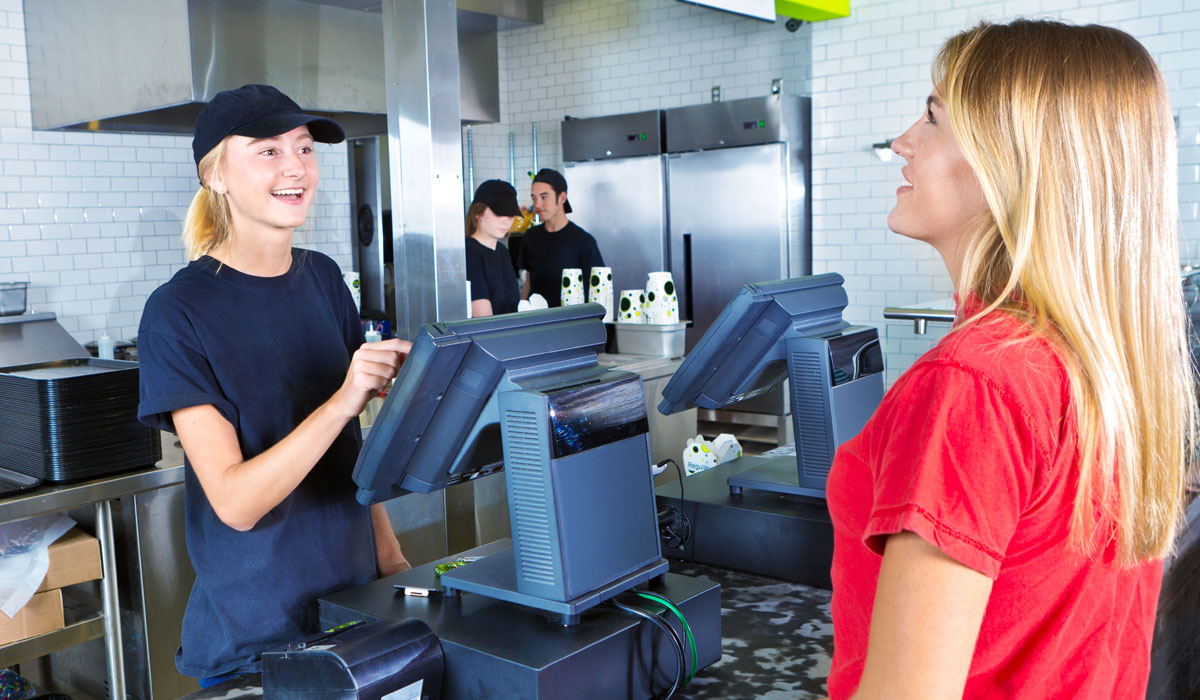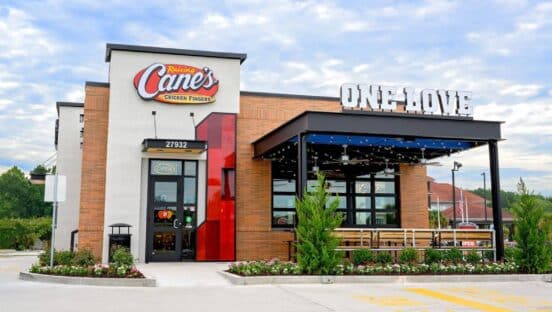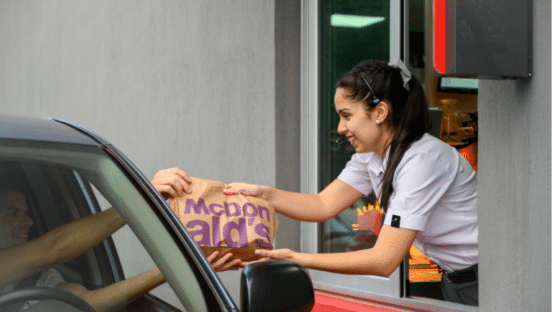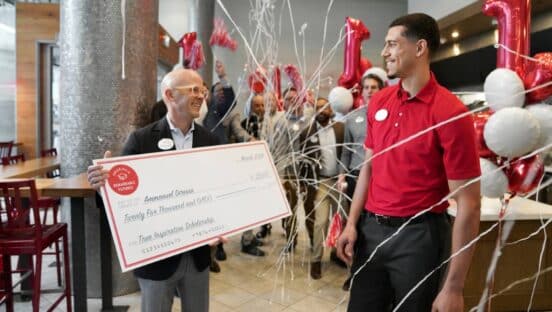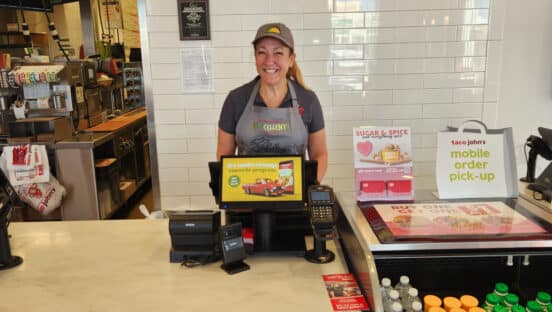No matter which direction you dissect the labor battle from, retention remains the hot zone. Displeased employees are a quick recipe for operational disaster. Turnover is costly from a balance-sheet perspective (as much as $14,000 for a single general manager, per TDn2K), but there are also less countable issues. Poor service often leads to poor reviews, which deter customers before they even give restaurants a shot. ReviewTrackers noted that Yelp averages more than 178 million unique visitors every month across its mobile, desktop, and app platforms. Per a 2018 study, roughly 45 percent of consumers said they were likely to check Yelp reviews before visiting a business. Nearly 65 percent said they look to Google.
Restaurateurs can debate the merits of these review sites for ages, but it doesn’t change the value of consumer behavior. And one bad server or cashier can punch a digital black eye into your business that won’t heal easily.
Also, unhappy employees foster a lack of accountability in restaurants. Staff might not show up. They call in late. Get sick last minute. All of these problems lead to an understaffed operation and a customer-experience proposition that falls short of the company guidebook.
And, of course, this is all becoming more pressing as the labor pool tightens and wage pressures rise. Just this weekend, Sun Capital-owned Restaurants Unlimited Inc. filed for bankruptcy, citing “progressive wage laws.” The multi-concept company’s chief restructuring officer David Bagley presented the problem in simple math:
Rising wages pushed annual wage costs up by $10.6 million. Divide that by 1,886 part-time hourly employees and you’re looking at $5,623 per part-time employee. And this at an operation already laced with razor-thin margins. It had revenues of $176 million in 2018, a percentage point decrease from the prior year. In the company’s Seattle market alone, wage costs jumped nearly 70 percent in the past three years from $9.47 to $16.
So the Catch-22 unfolds: Can restaurants afford to pay this added labor cost? If not, can they afford to operate with less staff and still remain competitive?
It’s yet another reason keeping quality employees engaged is a deal breaker for brands.
7shifts, a scheduling software platform, surveyed about 2,000 restaurant professionals, everyone from cooks to servers to juice bars and pizzerias, to determine what makes them happy in their restaurants, and what managers could do to improve workplace satisfaction.
The question at hand—is it pay or workplace engagement that affects restaurant turnover and impacts employees the most?
“The employee engagement study in particular tackles a critical issue facing the industry—the notorious 73 percent turnover rate,” 7shifts CEO Jordan Boesch says. “By evaluating restaurant employee happiness across North America, we can better understand what goes into making a happy, efficient restaurant, and share those insights for our restaurant friends to grow and retain their team.”
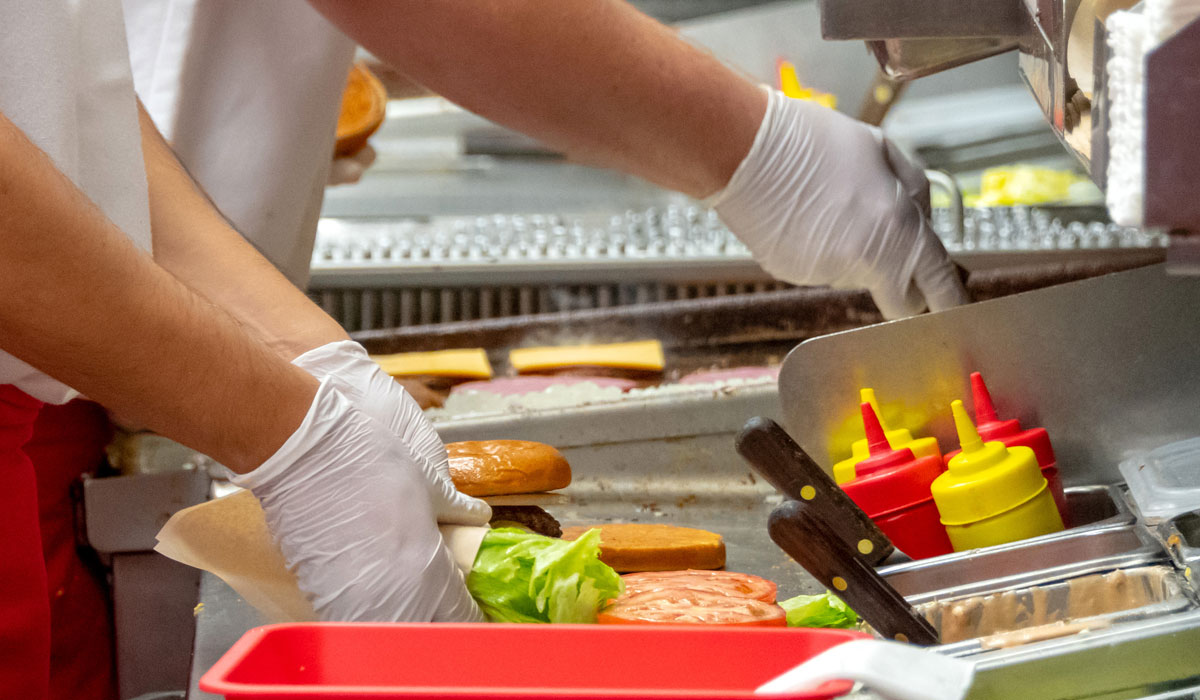
Firstly, it’s worth exploring what the current pool looks like. If you subtract managers, owners, and operators, most restaurant employees fall between the ages of 16–25. The average age of total restaurant workers is about 29, but guest-facing employees tend to be younger. As do the people prepping food and keeping the kitchen operational.
7shifts’ study data broke down as:
- 51 percent are servers/bartenders
- 22 percent are cooks
- 8 percent are hosts/hostesses
- 13 percent are other (cashier, barback, busser, etc.)
Let’s look at the employee wage stats.
- 44 percent of restaurant employees report making between $11–$15 per hour
- 33 percent make between $6–$10 per hour
- Only 16 percent of restaurant employees make a base of under $5 per hour, and 94 percent of these are servers or bartenders who make up the rest of their income through tips.
7shifts used the oft-cited Herzberg’s theory of motivation to start this discussion about workplace satisfaction.
This is explained in two ways: One, hygiene factors, defined as essential for motivation but not leading to long-term satisfaction. They prevent dissatisfaction yet do not lead to direct satisfaction in themselves. Things like pay, tips/bonuses/company policies.
The second are motivational factors, which are achieved in addition to hygiene factors and result in long-term satisfaction. Notes such as recognition, achievement, growth, responsibility, and the meaningfulness of work.
Using the two factors as a guidelines, 7shifts tackled the state of restaurant employee happiness. What it found: Despite high turnover rates, most employees reported being very happy at work across the board—an eight out of 10 on the overall happiness scale. More than 30 percent of restaurant employees reported a nine or 10.
Across all job types, engagement factors were essential. Training, workplace technology, communication, management, and coworkers ranked as the most impactful culprits for satisfaction.
An anonymous respondent said, “I believe that if the managers put as much time as they do in the workplace, engaging with their employees, the restaurant would be so much better and would receive more customers.”

7shifts asked respondents to rate the importance of different factors.
Role and tasks
Employees rated their job roles and work tasks as a 4/5 (1 is very unhappy, 5 is very happy). Fewer than 5 percent of employees said they were unhappy with their role. That’s a strong indicator of how important it is to fit employees into titles and tasks they’re suited for. Or, on the flip side, to promote workers who feel underutilized and to reassign those who are overwhelmed. Also, to cut employees who realize this line of work simply isn’t for them. Don’t let people idle when others would hit the ground running.
Their team
On average, restaurant employees rated their managers and coworkers 4/5 apiece. More than 40 percent said their managers and employees make them very happy at work. A vivid response from one person: “I think overall, to retain employees is to not have a transaction of ‘I pay you, you work for me’ but a transaction of shared values and respect. The leading cause of employee loss is management’s leadership.”
Fostering a workplace culture and friendly environment is vital. With younger workers, if they don’t feel they belong, they’ll likely bolt and go somewhere else. That isn’t so different from designing a store model, like Shake Shack did, to cater to a specific consumer. If customers aren’t comfortable dining, they’ll look for a brand that makes them feel part of a club. The same is true of employees. Additionally, if tasks aren’t assigned correctly, you could end up with your best employees carrying the water and others lounging, waiting for their next paycheck. That’s a quick way, in any industry, to ensure the company’s best assets seek friendlier confines and more goal-oriented peers.
Take this other anonymous quote: “Workplace happiness coincides with the effectiveness of all the workers as a machine. Even if work is hard, successfully navigating the work environment and satisfying both guest and manager is also satisfying to the employee. If every member in a team plays his/her part, the solidarity among team members will often make up for a bad day of work.”
Keeping dissatisfied workers around is a danger to quality employees.
Communication
This metric was a bit rocky. On average, respondents ranked the amount of communication with their workers as a 4/5, with 38 percent placing communication at a 5. Fewer than 8 percent said they were unhappy with communication at their restaurant.
When asked how employees would like to communicate with managers, more than 60 percent said via text message when not in person. Only 36 percent picked phone calls. Email was just 21 percent. Social media last at 10 percent.
Mobile innovation is here, and it’s important not just for communication but also for scheduling and task assignment. A purchase-to-pay and inventory system could allow managers to work on the go via a mobile app. This way they can get work done across devices without being tethered to the back office. Generally speaking, the more automated a GMs task, the more they can focus on running great restaurants. Collaborative scheduling, for instance, lets employees suggest times they’re not able to work or request shift swaps or drops. Managers can post open shifts so employees looking for extra hours can pick them up without costing the restaurant late adjustments. And that’s all approved through an app that automatically updates the schedule and saves GMs from positing new, printed versions that might get missed.
Another benefit: It creates an audit trail of how the schedule changed.
Having these systems is a smart unlock to lure today’s gig worker. Ensuring flexibility is one of the most valuable benefits to younger workers and one area restaurants can really gain ground over competitors. Getting that message out there, loud and clear, has game-changer potential for operators looking to other industries, like retail, for similar-minded employees.
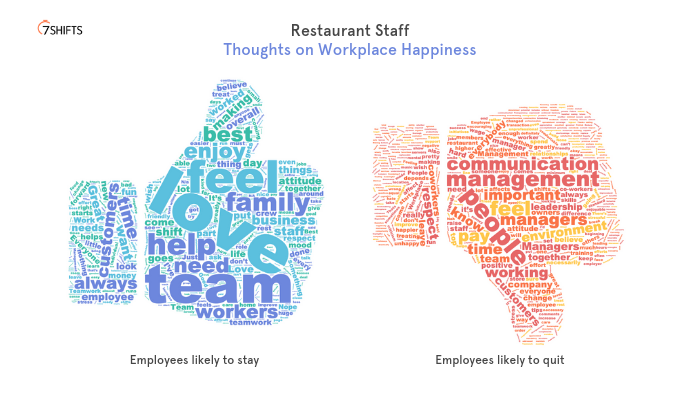
Training
Restaurant employees ranked training a 4/5 on average, with 30 percent giving it a 5. Training is really the lifeblood of every point made so far. If employees don’t know what they’re doing, they won’t feel confident. And if they’re not confident, your restaurant’s service is likely going to suffer. Also, training draws a clear career path for employees to aspire to and stay engaged for, thus leading to retention.
One other factor often cited by operators: when employees invest in learning systems and education, they tend to stick around. That or they might leave before running through the process, which isn’t always a bad thing.
7shifts found that the biggest difference between employees likely to quit and those who will stay is the amount of training they receive. The employees likely to churn rated the training they received from management a 3. Those who said they weren’t going to quit gave it a 4. The “at-risk” employees wanted hands-on training from managers (67 percent), to shadow senior employees (40 percent), and to take external courses (23 percent).
Restaurants can get a leg up by offering ongoing training and support. To emphasize the learning opportunities available in a restaurant career, operators should offer not just on-boarding training but also ongoing skills training. More on this later.
Positive recognition
Employees said, generally, they were pleased with the recognition they received from management. However, more than 35 percent reported it as inadequate. One of the big reasons employees quit is due to bad managers. Engaged employees rated their happiness with management at a 4/5. Those likely to churn ranked it a 3.
Employees planning to quit also said they were extremely unhappy with the amount of recognition they received. The at-risk workers rated recognition from management a 3/5.
Basically, there’s room to improve, as the chart below gets into.
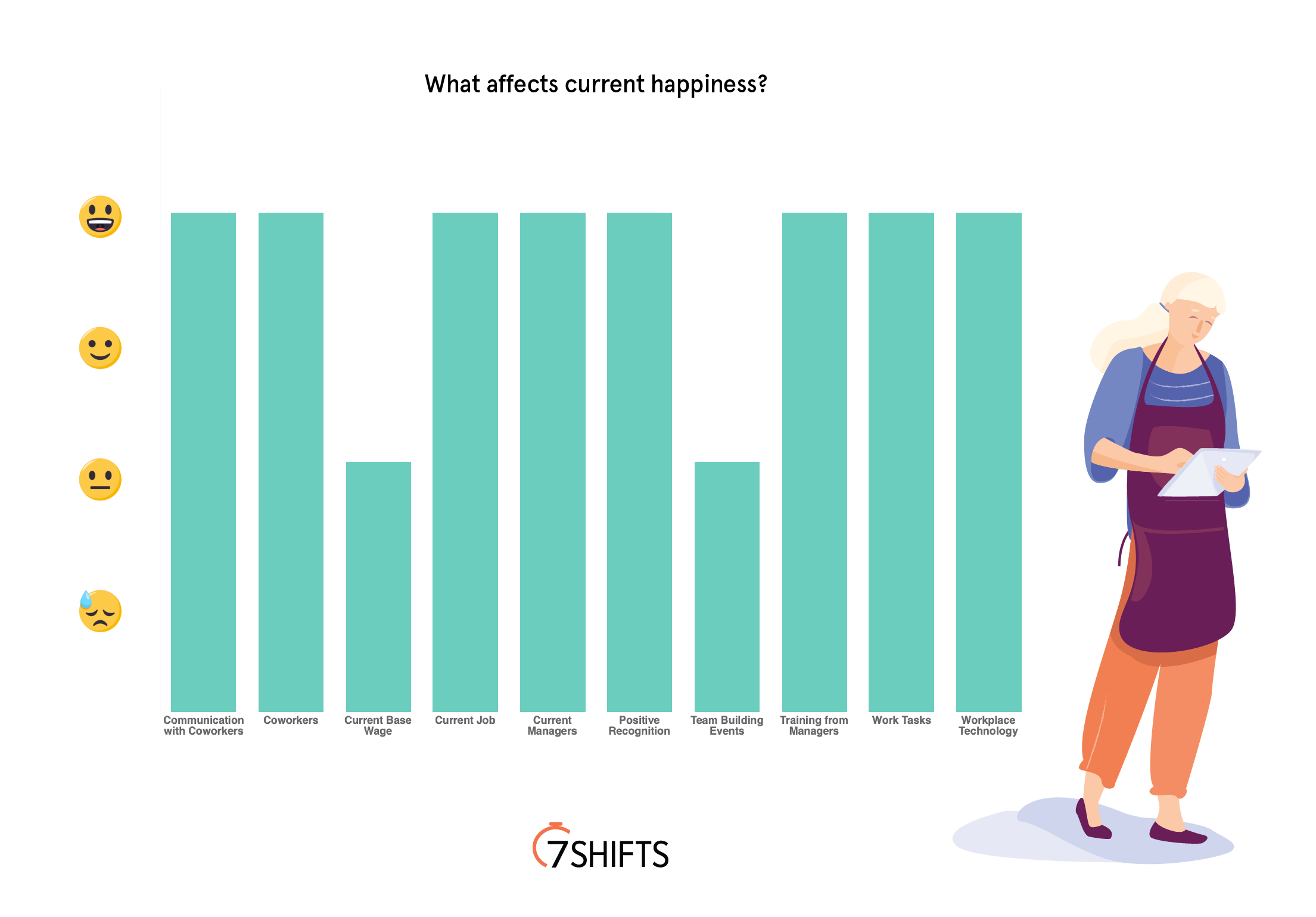
The future
Those aforementioned factors explain what employees enjoy in their current workplaces. But what do they want to increase workplace happiness?
Can operators do better than an 8/10?
“Keeping employees happy is one thing, but it’s the continuous drive to stimulate and engage your employees that keeps them from turning over,” 7shifts said.
The company asked employees to rank, on a scale of 1–10, how much these following points would affect workplace happiness. These are the results, from most important to least important.
A pay increase
Say what you will about gig benefits and cultural missions, money always talks. A happier employee is often a higher-paid one. Twenty-four percent rated a pay increase at a 4.5, and 62 percent said it’s a 5. No matter the age, wage or position, all employees in the study said a pay increase would affect their future happiness at work.
It’s an age-old recognition cure. Employees need to feel as though they can support themselves and work hard to get there (hygiene benefit). The engagement bonus is workers will be happy and continue to perform well (motivation).
The two-factor Herzberg theory says that restaurant managers must ensure hygiene factors are properly met, including adequate wage, to avoid dissatisfaction, and ensure the work is rewarding enough to encourage employees to perform. If turnover is a major issue at your restaurant, ask these questions: Are you paying enough to keep workers from looking elsewhere? Can employees support themselves on the money (and shifts) you’re giving them? What else is being offered above and beyond the monetary compensation?
An anonymous quote from a respondent: “I wouldn’t necessarily be happier at work with a pay raise but I would definitely not want to quit all the time and have more incentive.”
Another: “I need money to live, so it’s kind of unfortunate a job I even like is potentially out the window because it cannot allow me to pay bills.”
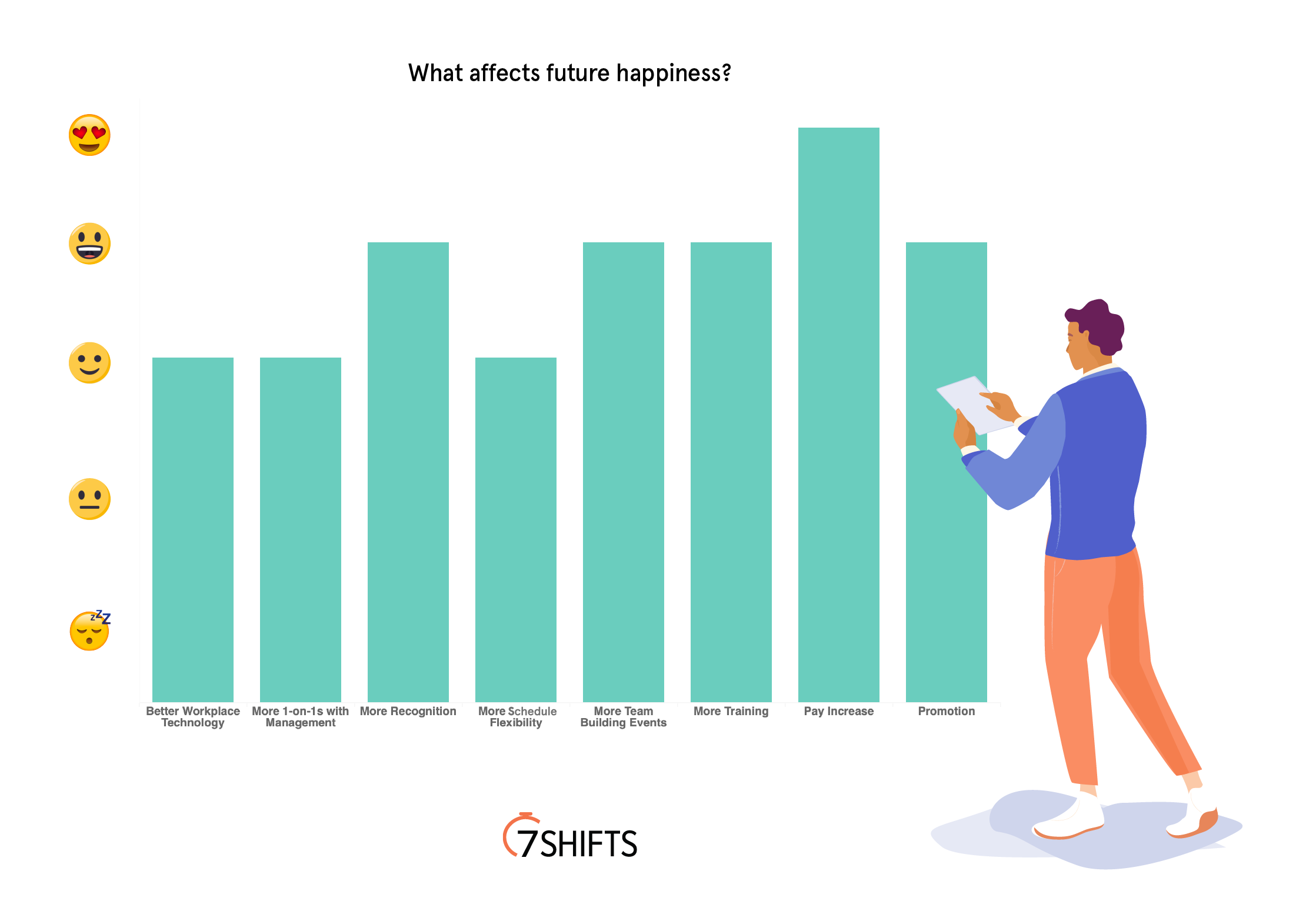
Climb the ladder
Being promoted (often comes with a raise) is also a sure-fire sign of formal recognition. More than 60 percent of workers said a promotion would markedly increase their workplace happiness in 7shifts’ study. All positions agreed.
Higher pay and benefits are great, but employees won’t stick around if they feel stifled by a restaurant’s corporate structure. This is an industry where nine out of 10 restaurant managers and eight out of 10 restaurant owners started their careers in entry-level positions, according to the National Restaurant Association. That’s a powerful story to tell if it’s communicated properly.
Chipotle, in one example, provides a development path from day one. Crew—kitchen manager—service manager—apprentice—general manager—restaurateur—certified training manager—field leader—team director—executive team director.
In 2018, the fast casual promoted 13,689 people at all levels, with its internal promotion rate at 79 percent.
Workers won’t grow with a company if they feel trapped by a lack of opportunity.
More recognition from management
You don’t have to pay or promote someone to let them know they’re doing good work. Here are the kinds of recognition respondents credited:
- 67 percent of restaurant employees said they would like to receive paid bonuses as recognition from management
- 38 percent would like public kudos
- 32 percent would like promotions
- Nearly 30 percent would like to receive seniority benefits like time-off priority or better benefits
- 21 percent want to have employee-of-the-month rewards
Some of the respondents also indicated they would enjoy staff parties and celebrations to recognize when the team has performed well. Many were happy with a simple “good job” from their manager.
An anonymous response: “Happiness in the workplace comes from managers owners and employees as a whole. If managers don’t appreciate their employees, why should they work so hard? Recognition for the things nobody else does is huge! Just one compliment can hold someone over for a very long time but also keeping in mind one negative mean or rude comment can erase all the positive ones in an instant.”
The power of team building
Nearly 60 percent of restaurant staff said more team building events and activities would improve workplace happiness. Fewer than 10 percent said it would not impact their workplace happiness at all.
Even so, more than 50 percent of restaurant employees reported not having any team building activities at their restaurant. This is a solid opportunity for operators to cultivate a staff and workplace setting that stands out from the pack. And happy teams tend to feed of one another and inspire retention.
A response: “I believe that happiness in the workplace can’t be bought but made—not necessarily by having weekly/monthly bonuses, but to have more activities that encourage the worker to be more responsible, out-going, and free of self-decisions.”

That training challenge
Fifty percent ranked more training as a 4 or 5 on the impact scale. Twenty percent said, however, they didn’t need more training and it would not impact their workplace happiness. Dishwashers, hosts, and servers felt fairly neutral about more training. Cooks requested more training than other roles. Cafes, bars and breweries, fast food, and pizzerias indicated that more training would be more impactful for their workplace happiness.
Even if employees don’t feel they need it, training is a way to get workers more invested in your restaurant. When people put that investment in, they simply care more. And they have more pride about their role and take ownership of it.
In the study, about 70 percent said they wanted hands-on training from managers; 40 percent want to shadow senior employees; and 22 percent would like external course training. Nine percent also said they’d enjoy training videos or reading materials. In restaurants that serve alcohol, many employees indicated that they would like to learn more about the selection of beer, wine, and other drinks they offer to better serve staff and make good suggestions.
Quick- and full-service employees will do a poor job upselling and cross selling if they don’t understand the offerings. The opposite effect is true if they’re well trained and believe in the products.
A response: “More than anything, being further trained and promoted to a more senior title would make me happier.”
Forty-five percent of employees said a more flexible schedule would greatly impact their happiness.
Some combination of all the methods—buddy system training, digital, top-down—will likely be most effective for an evolving workforce. Shoulder-to-shoulder training, in-restaurant meetings and training, and video training provide employees with the equivalent of 15 days of training each year at Chipotle. Kitchen managers and apprentices receive six weeks of training. Service managers get four.
At the same time, the fast casual has a “Cultivate U 2.0” program that aims to shift current mindsets from a “tribal knowledge,” mentality to an aligned approach within restaurants. Field leaders go through a series of workshops intended to build leadership skills and increase engagement, and it all trickles down.
Better workplace technology
Sixty-five percent of employees said they were satisfied with the tech they use on the job. Workers only rated “better workplace technology” as a 3/5 on how much it would impact their happiness. Quick-service employees gave it a 4/5. But overall, only 44 percent of employees said better workplace technology would markedly improve their happiness.
All that said, equipping employees with tools that don’t hinder, but rather improve their work processes is essential not only in staff satisfaction, but also with efficiency and service, 7shifts said.
More schedule flexibility
Fifty-five percent said they didn’t think a more flexible schedule would greatly impact their happiness. That still leaves 45 percent who do think so. Quick service and juice bar staff ranked highest.
Flexibility is important to attract students and part-time employees—often the engines of quick-service restaurants. “Scheduling the appropriate amounts of people is more important to workplace happiness than most of the things I’ve seen here,” one respondent said. “Gross under-scheduling leads to overwhelming stress that no pay raise can fix.”
More meetings
About 44 percent of employees said more face time with management one-on-one or in groups would improve their workplace happiness. More than half said it wouldn’t greatly impact them. Still, communication and interaction could be beneficial to workplace productivity and efficiency as much as satisfaction.
As 7shifts points out, managers can relay menu updates, check on morale, and strengthen bonds.
“The biggest difference between engaged employees and employees who are going to quit is their current satisfaction with their managers, training, team building activities, and the amount of recognition they receive from management,” the company said.

